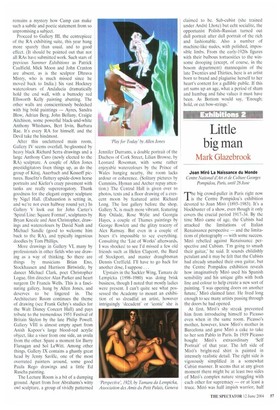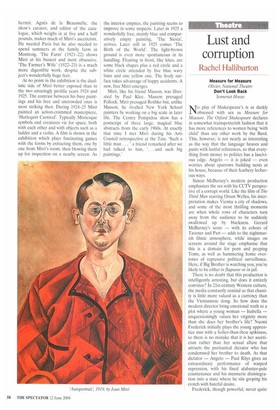Little big man
Mark Glanbrook
Joan Mini La Naissance du Monde Centre National &Art et de Culture Georges Pompidou, Paris, until 28 June
The big crowd-puller in Paris right now is the Centre Pompidou's exhibition devoted to Joan Mini (1893-1983). It's a blockbuster of a show, even though it only covers the crucial period 1917-34. By the time Miro came of age, the Cubists had attacked the limitations of Italian Renaissance perspective — and the limitations of photography — with some success. Miro rebelled against Renaissance perspective and Cubism. 'I'm going to smash their guitar,' he said. It sounds childishly petulant and it may be felt that the Cubists had already smashed their own guitar, but the Centre Pompidou exhibition reveals how imaginatively Mir6 used his Spanish sensibility and his unique gifts with both line and colour to help create a new sort of painting. 'I was opening doors on another future,' Mir6 claimed later. He lived long enough to see many artists passing through the doors he had opened.
At first. MirO's shy streak prevented him from introducing himself to Picasso even when in the same room. Picasso's mother, however, knew Miro's mother in Barcelona and gave Mir6 a cake to take to her son Pablo in Paris. In 1919 Picasso bought Miro's extraordinary 'Self Portrait' of that year. The left side of Miro's bright-red shirt is painted in intensely realistic detail. The right side is vigorously simplified in a somewhat Cubist manner. It seems that at any given moment there might be at least two sides of Mir6's complex nature struggling with each other for supremacy — or at least a truce. Miro was half impish warrior, half hermit. Agnes de la Beaumelle, the show's curator, and editor of the catalogue, which weighs in at five and a half pounds, makes much of Mir6's asceticism. He needed Paris but he also needed to spend summers at the family farm in Montroig. 'The Farm' (1921-22) shows Mir6 at his busiest and most obsessive. 'The Farmer's Wife' (1922-23) is a much more digestible work, despite the subject's wonderfully huge feet.
At no point in the exhibition is the dualistic side of Mir6 better exposed than in the two amazingly prolific years 1924 and 1925. The contrast between his busy paintings and his free and uncrowded ones is most striking then. During 1924-25 Mir6 painted an action-crammed masterpiece, 'Harlequin Carnival'. Typically MirOesque symbols and creatures vie for space, both with each other and with objects such as a ladder and a violin. A film is shown in the exhibition which plays fascinating games with the forms by extracting them, one by one from MirO's room, then blowing them up for inspection on a nearby screen. As the interior empties, the painting seems to improve in some respects. Later in 1925 a wonderfully free, mainly blue and comparatively empty painting, The Siesta', arrives. Later still in 1925 comes 'The Birth of the World'. The light-brown ground is even more spontaneous in its handling. Floating in front, like kites, are some black shapes plus a red circle and a white circle attended by five blue wavy lines and one yellow one. The lively surface takes advantage of happy accidents. A new, free Miro emerges.
Mir6, like his friend Masson, was liberated by Paul Klee. Masson presaged Pollock. Miro presaged Rothko but, unlike Masson, he rivalled New York School painters by working on a big scale in later life. The Centre Pompidou show has a postscript of three large, magical blue abstracts from the early 1960s. At exactly that time I met Mir6 during his Arts Council retrospective at the Tate. 'Such a little man . ' a friend remarked after we had talked to him, . . and such big paintings.'



















































































 Previous page
Previous page